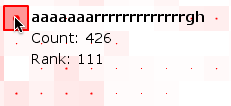Text Clouds and Advertising: Microsoft’s Community Buzz Project
Thanks to Datamining, for posting a writeup and screenshot of a prototype of Community Buzz, which features a text cloud. Community Buzz is a Microsoft Research project, and this is a perfect use of a text cloud to visualize concepts and further comprehension in a body of text.
More interesting than the text cloud is the space in the screenshot that looks like a placeholder for advertising driven by the contents of the text cloud. The annotation reads “Contextual ads based on the Buzz cloud keywords”, implying an advertising based revenue mechanism driven by creation and analysis of a text cloud.
The description of Community Buzz posted on the TechFest 2007 page, includes the following, making the connection to an advertising model explicit:
Community Buzz combines text mining, social accounting (Netscan/MSR-Halo), and new visualization techniques to study and present the content of communication threads in online discussion groups. The merging of these research technologies results in a system that gives great value to community participants, enables highly directed advertising, and supplies rich metrics to product managers.
Assuming it’s possible to provide highly directed advertising and rich metrics based on text clouds, I can see the benefits of for advertisers and product managers, and researchers of many kinds. Yet I’m not convinced of the benefits for community participants. Where will the text clouds come from, and how will their content reflect the needs of the community? How will social dynamics shape or affect these text clouds, to make it possible for them to leverage network effects, differential participation, and the scale benefits of connected social systems?
Text clouds – at least at this stage of development – support rapid but shallow comprehension: maybe this is perfect for advertising purposes…
Like a pile of dry bones that used to make up a skeleton, text clouds lack the specific structure and context of their source, and so cannot replace comprehension. Text clouds deconstruct the word elements that make up a body of text the same way spectrum analysis identifies the different wavelengths of light from a distant star. It’s a bit like using statistical analysis to read King Lear, instead of using a variety of tools to learn more about what Lear might have to say.
A better use of text clouds, or any other type of deconstructive method (a variant of semiotics) is as a tool for enhancing comprehension. Text clouds seem to bypass distinctions between high context and low context that present barriers to understanding deep context, by focusing on the raw content of the source, on the level of it’s constituent elements.
The goal of examining the fundamental or essential makeup of something we’re exploring – as a way of better understanding that thing overall – is an epistemological method pursued by Plato and a host of other Western philosophers and natural scientists. We should be cautious with new tools, however, as the urge to illuminate and dissect the fundamental makeup of that which is complex and nuanced can go too far, crossing from the insightful to the sterile domain of soulless reductivism. Witness the responses of corrupt officials to Javier Bardem’s character Agustín, in John Malkovich’s directorial debut The Dancer Upstairs.
Agustín is a police hero who saves his country from a criminal and oppressive government, social disintegration, and guerilla takeover. He then surrenders all prospects of winning the presidency and leading his struggling nation to prosperity for the unrequited love of a woman who aided the same guerilla leader he helped capture. Agustín strikes a secret bargain to secure her freedom with the corrupt powers that be, on condition that he withdraw from public life. His choice is incomprehensible to the soulless officials in power. To these people, who buy, sell, and execute hundreds without a thought, Agustín’s lover “…is just a girl – 70% water.”
For reference, the overview of Community Buzz:
- Community Buzz combines analysis of the content of online discussions and social structure of the communities to identify hot topics and visualize how they evolve over time.
- Through search and Buzz cloud users can access relevant discussion threads and adverts linked to the search results and Buzz keywords.
- Visualization of keyword trends enables the users to monitor the popularity of selected topics. Mesasages can be filtered based on the ‘social status’ of the author in the community.
And the complete description of the demo mentioned by Datamining:
Community Buzz is a new window into online communities! Interesting and useful conversations, authors, and groups are discovered easily using this tool, jointly developed by Microsoft Research Redmond’s Community Technologies group and Microsoft Research Cambridge’s Integrated Systems team, with sponsorship from Live Labs. Community Buzz combines text mining, social accounting (Netscan/MSR-Halo), and new visualization techniques to study and present the content of communication threads in online discussion groups. The merging of these research technologies results in a system that gives great value to community participants, enables highly directed advertising, and supplies rich metrics to product managers.


